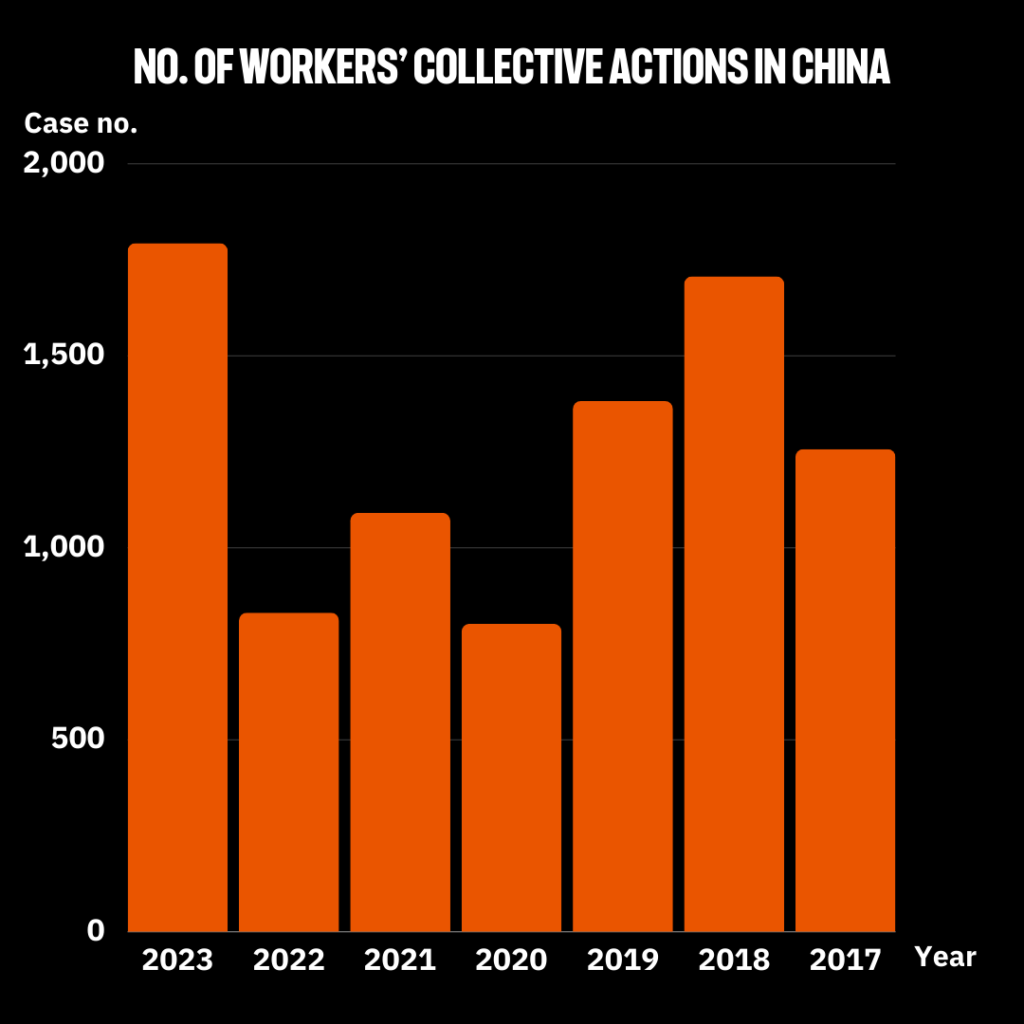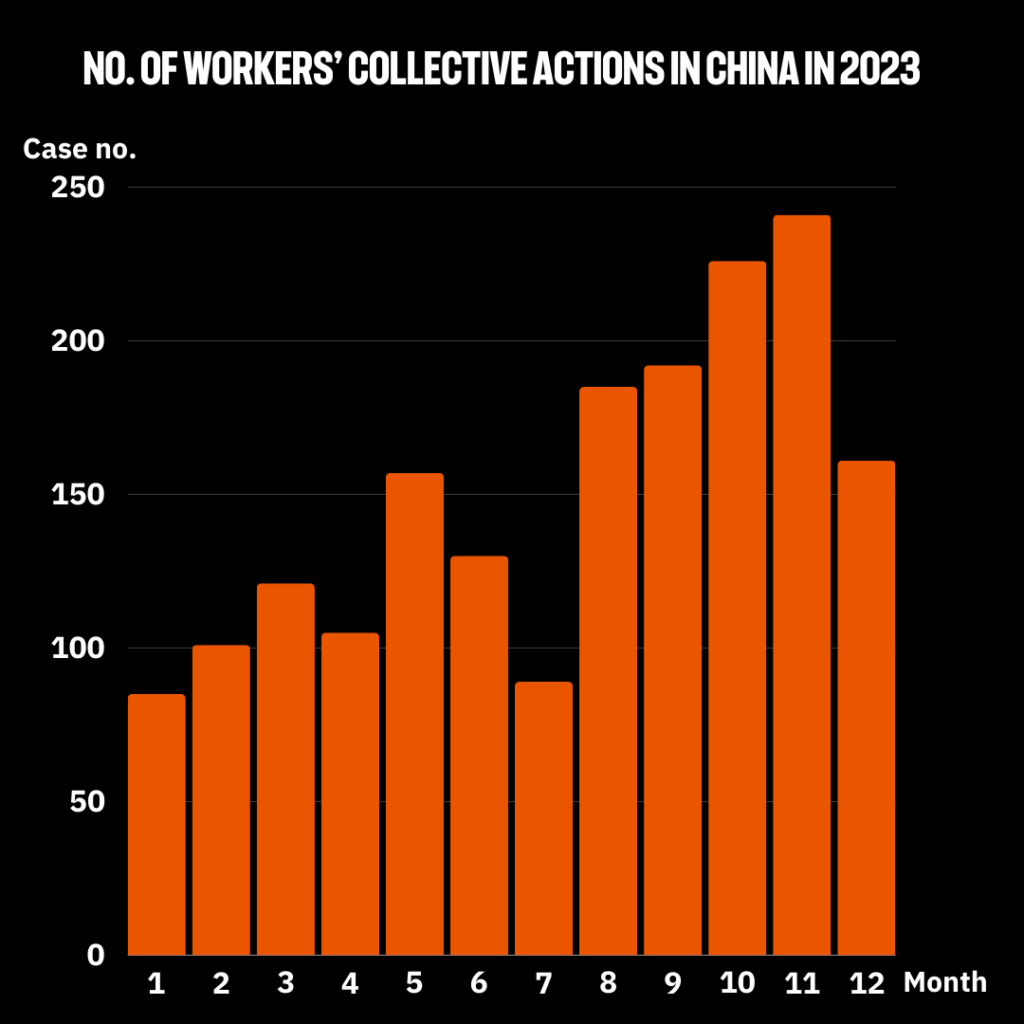China’s post-pandemic economic recovery has not been as expected, with a wave of business closures and layoffs in various places. Workers are being exploited by wage arrears, wage cuts, and unpaid overtime. According to the China Labour Bulletin (CLB), a labour rights group for workers in China, there were 1,793 collective actions by workers in China in 2023, more than double the number in 2022 and a record high in nearly seven years. China’s economic downturn has led to many labour disputes, and with the youth unemployment rate persistently high, social unrest has become an issue in China.
Since 2011, CLB has been building an online map database to compile a workers’ collective action map (the map), recording labour disputes and rights protection cases across China. According to the map, there were 1,793 collective actions by workers in China last year, 1.15 times more than the 831 cases in 2022. Workers’ collective action began to increase in the second half of 2023, with more than 1,000 cases in the first half of the year, recording 241 cases in November alone, the highest number in a month since the map began to collect data.
342 strikes happened in 2023, with over 50 per cent ending up with police intervention
Workers’ rights protection incidents were spread across every province and city, with Guangdong Province accounting for the majority, with 516 cases last year. The construction and manufacturing industries had the largest number of labour disputes, with 944 and 436 cases, respectively, which is believed to be related to the debt crises of China’s leading real estate companies and the difficult business environment during the post-pandemic period. Last year, as many as 563 cases of collective action by workers involved wage arrears and 211 cases of disputes caused by relocation or closure of factories.
Even worse, Chinese workers do not have the right to strike. Workers are often forced to strike at a point where the exploitation becomes intolerable. However, the lack of support from trade unions increases the risk of defending their rights. In 2023, 342 labour actions turned into strikes, 1.2 times more than 155 strikes in 2022. For example, on 16 October 2023 alone, the map recorded a strike by drivers of the online truck-hailing platform Huolala (known as Lalamove in Hong Kong) in Foshan of Guangdong Province, Hengyang of Hunan Province, and Chengdu of Sichuan Province. This was the second strike by truck drivers after last May, ending with government intervention.
Although the number of strikes in China has surged over the past year, the government often suppresses the protests at an early stage. Workers were arrested for protesting unpaid wages and compensation in seven cases out of the 181 protests intervened by the police last year. According to CLB, more than 1,000 workers went on strike in April last year at the Guangyue Garment Factory in Jiaxing, Zhejiang Province, a supplier of sports brands such as Nike and Adidas, because of sharp wage cuts. In November last year, the relocation of the Hangzhou-based Taiwanese De Licacy Industrial Co., Ltd. triggered a mass strike, and the government dispatched many police officers to suppress the strike.
Trade unions do not fight for workers’ rights
There is no independent trade union in China. The only legal trade union, the All-China Federation of Trade Unions, was founded on 1 May 1925 and is under the control of the Communist Party. Given the surge of labour disputes in the past year, the trade unions have always intervened in a limited manner and even sold out workers’ rights to quell incidents as soon as possible. For example, last May, when a shoe-making factory in Jinjiang City, Fujian Province, broke the news that many workers had gathered outside the factory to chase their wage arrears before it relocated, CLB contacted the local trade union. Still, the union shirked its responsibility because the workers were not registered with them. During the dispute over the relocation of the Shenzhen Yunfeng Electronics factory last May, workers were dissatisfied with the arrangement and launched a strike; dozens of people took to the rooftop to protest, which lasted for 20 days. At that time, the factory’s labour union intervened and asked the higher-level union to help facilitate the negotiation. The reply was, ‘No such plan at present’. Trade unions fail to represent workers, who can only fight for their rights and interests independently. If the situation of workers reaches tipping point and a fierce protest is triggered, the consequences could be unpredictable.
The number of workers’ collective actions last year hit the highest since 2017, while the number of cases reached a new low during the three years from 2020 to 2022, with cases ranging from 802 to 1,091 per year. CLB explained that COVID-19 prevention policies, such as lockdowns, had led to job insecurity during the pandemic. However, when the pandemic ended, the problem of unpaid wages became more serious, and the workers became impatient with the exploitation and took to the streets.
Nine labour disputes related to the government, laying the ground for social instability
It is worth noting that nine of the workers’ rights actions last year involved party/government officials, the latest of which occurred on 6 November last year, when hundreds of employees of the Jizhou District Transportation Bureau in Tianjin went on strike outside the building for two consecutive days to protest the bureau’s arrears of nine months’ wages and five months’ provident fund. This is undoubtedly a sign to the Chinese government that they are facing a serious governance warning.
China’s post-pandemic economic recovery is sluggish, hit by challenges such as the downturn in the real estate market, the decline in overseas orders and weak domestic demand. Some analysts even point out that there will only be more unemployment and wage cuts. Since China announced in June last year that the youth unemployment rate had reached 21.3 per cent, a record high, it has stopped releasing relevant youth unemployment data. Until recently, China announced that the unemployment rate dropped to 14.9 per cent in December last year after the government had excluded 62,000,000 in-school youngsters from the survey. It is conceivable that youth unemployment is causing great concern to China’s leaders.
China’s current economic crisis is fraught, with many scholars predicting that the economy will continue declining. A group of young people with an uncertain future, combined with resentful workers under employers’ exploitation, are poised to lay the foundation for social instability in China.



